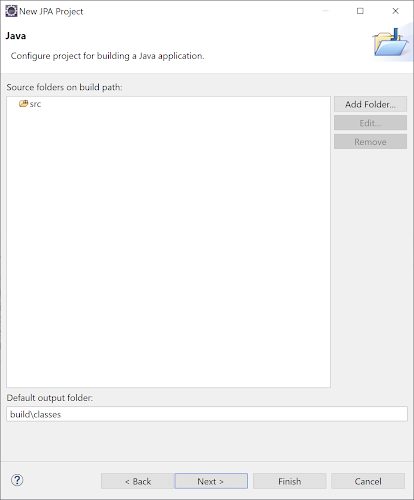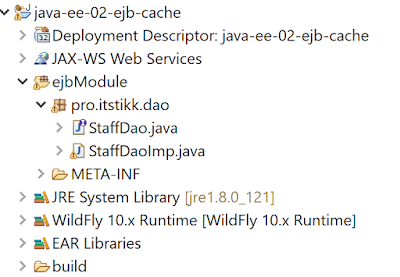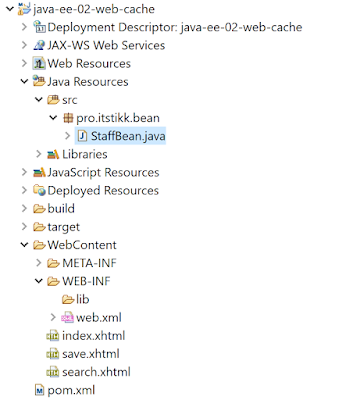Caching is very import technique to improve performance on inquiry. Especially, if you are working with a heavy query that need to join many tables or to retrieve huge amount of the data from the database. Without caching, every single time that data query is executed, disk access happened. This is not a practical manner to handle data inquiry and lead to poor system performance. Accessing data without fetching data directly from the disk could increase data inquiring speed dramatically. Caching inquiry result in the memory and reuse that data is very common practice once it come to handle heavy query or huge amount of data.
Hibernate provides implementation of JPA. It provides first level cache, second level cache and query cache. For the first level cache, it is enable by default. In this post, I will demonstrate how to enable second level cache in both JPA and Hibernate with Wildfly.
JPA with Second Level Cache
JPA provide second level cache but not by default, you need to enable it through persistence.xml. First, you have to create JPA project

|
|
Fig 01. Create JPA Project 01 |

|
|
Fig 02. Create JPA Project 02 |

|
|
Fig 03. Create JPA Project 03 |

|
|
Fig 04. Create JPA Project - 04 |

|
|
Fig 05 Create JP Project 05 |
Create JPA Class from Table as below.

|
|
Fig 06 Create JPA Class |
package pro.itstikk.jpa.entity;
import java.io.Serializable;
import javax.persistence.Cacheable;
import javax.persistence.Entity;
import javax.persistence.Id;
import javax.persistence.NamedQuery;
import javax.persistence.Table;
/**
* The persistent class for the stafftbl database table.
*
*/
@Entity
@Table(name="stafftbl")
@Cacheable
@NamedQuery(name="Staff.findAll", query="SELECT s FROM Staff
s")
public class Staff implements Serializable {
private static final long
serialVersionUID = 1L;
@Id
private String staffid;
private String
firstname;
private String
lastname;
public Staff() {
super();
}
public String getStaffid()
{
return this.staffid;
}
public void setStaffid(String
staffid) {
this.staffid = staffid;
}
public String getFirstname()
{
return this.firstname;
}
public void
setFirstname(String firstname) {
this.firstname =
firstname;
}
public String getLastname()
{
return this.lastname;
}
public void
setLastname(String lastname) {
this.lastname =
lastname;
}
}
Next is to configure persistence.xml
<?xml version="1.0" encoding="UTF-8"?>
<persistence version="2.1"
xmlns="http://xmlns.jcp.org/xml/ns/persistence"
xmlns:xsi="http://www.w3.org/2001/XMLSchema-instance"
xsi:schemaLocation="http://xmlns.jcp.org/xml/ns/persistence
http://xmlns.jcp.org/xml/ns/persistence/persistence_2_1.xsd">
<persistence-unit
name="java-ee-02-jpa-ehcache" transaction-type="JTA">
<provider>org.hibernate.jpa.HibernatePersistenceProvider</provider>
<jta-data-source>java:/sampledbs</jta-data-source>
<mapping-file>META-INF/orm.xml</mapping-file>
<class>pro.itstikk.jpa.entity.Staff</class>
<shared-cache-mode>ALL</shared-cache-mode>
<properties>
<property
name="hibernate.dialect"
value="org.hibernate.dialect.PostgreSQLDialect"/>
<property
name="hibernate.connection.driver_class"
value="org.postgresql.Driver"/>
<property
name="hibernate.show_sql" value="true"/>
<property name="hibernate.format_sql" value="true"/>
<property
name="hibernate.cache.use_second_level_cache" value="true" />
<property
name="hibernate.cache.use_query_cache" value="true" />
<property
name="hibernate.generate_statistics" value="true" />
</properties>
</persistence-unit>
</persistence>
For orm.xml is mapping file. I have create as below.
<?xml version="1.0" encoding="UTF-8"?>
<entity-mappings
xmlns="http://java.sun.com/xml/ns/persistence/orm"
xmlns:xsi="http://www.w3.org/2001/XMLSchema-instance"
xsi:schemaLocation="http://java.sun.com/xml/ns/persistence/orm
http://java.sun.com/xml/ns/persistence/orm_2_0.xsd"
version="2.0">
<named-native-query name="STAFF.SQL.00"
result-set-mapping="STAFF.MAPPING">
<query>SELECT * FROM
stafftbl</query>
</named-native-query>
<named-native-query name="STAFF.SQL.01"
result-set-mapping="STAFF.MAPPING">
<query>SELECT * FROM
stafftbl s WHERE s.staffid = :ID</query>
</named-native-query>
<sql-result-set-mapping
name="STAFF.MAPPING">
<entity-result
entity-class="pro.itstikk.jpa.entity.Staff">
<field-result
name="staffid" column="staffid"/>
<field-result
name="firstname" column="firstname"/>
<field-result
name="lastname" column="lastname"/>
</entity-result>
</sql-result-set-mapping>
</entity-mappings>
Create EJB Project
To create DAO (Data Access Object), you just need to create EJB project.

|
|
Fig 07. EJB Project Creation |
Create Interface and the interface implementation class.
package pro.itstikk.dao;
import java.util.List;
import javax.ejb.Remote;
import pro.itstikk.jpa.entity.Staff;
@Remote
public interface StaffDao {
public void save(Staff
staff);
public List<Staff>
getStaffs();
public List<Staff>
list();
public Staff find(String
id);
}
For the implementation class is implemented as below.
package pro.itstikk.dao;
import java.util.List;
import javax.ejb.Stateless;
import javax.persistence.EntityManager;
import javax.persistence.PersistenceContext;
import javax.persistence.Query;
import javax.persistence.TypedQuery;
import javax.transaction.Transactional;
import pro.itstikk.jpa.entity.Staff;
/**
* Session Bean implementation class StaffDaoImp
*/
@Stateless
public class StaffDaoImp implements StaffDao {
@PersistenceContext(unitName="java-ee-02-jpa-ehcache")
private EntityManager
em;
/**
* Default constructor.
*/
public StaffDaoImp() {
super();
}
@Override
public List<Staff>
getStaffs() {
TypedQuery<Staff> query
= em.createNamedQuery("Staff.findAll", Staff.class);
List<Staff> list =
query.getResultList();
return list;
}
@Override
public List<Staff>
list() {
Query query =
em.createNamedQuery("STAFF.SQL.00");
return
query.getResultList();
}
@Override
public Staff find(String id)
{
Query query =
em.createNamedQuery("STAFF.SQL.01");
query.setParameter("ID",
id);
return (Staff)
query.getSingleResult();
}
@Transactional
@Override
public void save(Staff staff)
{
em.persist(staff);
}
}
Create Web Dynamic Project
To demonstrate interface to EJB project and CRUD operation, I just create Web Dynamic Project

|
|
Fig 08. Create Dynamic Web Project |
to map xhtml view interface, create managed bean
package pro.itstikk.bean;
import java.util.List;
import javax.annotation.PostConstruct;
import javax.ejb.EJB;
import javax.enterprise.context.RequestScoped;
import javax.inject.Named;
import pro.itstikk.dao.StaffDao;
import pro.itstikk.jpa.entity.Staff;
@Named("staffBean")
@RequestScoped
public class StaffBean {
@EJB
private StaffDao
staffDao;
private List<Staff>
list;
private String staffid;
private Staff staff;
public StaffBean() {
super();
}
@PostConstruct
public void init() {
staff = new Staff();
}
public List<Staff>
save(){
staffDao.save(staff);
list = staffDao.list();
staff = new Staff();
return list;
}
public Staff find(){
staff =
staffDao.find(staffid);
return staff;
}
public List<Staff>
getList() {
list = staffDao.list();
return list;
}
public void
setList(List<Staff> list) {
this.list = list;
}
public String getStaffid()
{
return staffid;
}
public void setStaffid(String
staffid) {
this.staffid = staffid;
}
public Staff getStaff()
{
return staff;
}
public void setStaff(Staff
staff) {
this.staff = staff;
}
}
Here is index.xhtml
<!DOCTYPE html PUBLIC "-//W3C//DTD XHTML 1.0 Transitional//EN"
"http://www.w3.org/TR/xhtml1/DTD/xhtml1-transitional.dtd">
<html xmlns="http://www.w3.org/1999/xhtml"
xmlns:rich="http://richfaces.org/rich"
xmlns:ui="http://java.sun.com/jsf/facelets"
xmlns:f="http://java.sun.com/jsf/core"
xmlns:a4j="http://richfaces.org/a4j"
xmlns:h="http://java.sun.com/jsf/html">
<h:head>
<title>JPA
Cache</title>
</h:head>
<body>
<rich:panel>
<f:facet name="header">
Write your own custom rich components
with built-in AJAX support
</f:facet>
<div style="margin: 30px 0
30px 0;">
<rich:dataTable var="item"
value="#{staffBean.list}">
<f:facet
name="header">
<rich:columnGroup>
<rich:column
rowspan="1">
<h:outputText
value="STAFFID" />
</rich:column>
<rich:column
rowspan="1">
<h:outputText
value="FIRSTNAME" />
</rich:column>
<rich:column
rowspan="1">
<h:outputText
value="LASTNAME" />
</rich:column>
</rich:columnGroup>
</f:facet>
<rich:column
rowspan="1">
<h:outputText
value="#{item.staffid}" />
</rich:column>
<rich:column
rowspan="1">
<h:outputText
value="#{item.firstname}" />
</rich:column>
<rich:column
rowspan="1">
<h:outputText
value="#{item.lastname}" />
</rich:column>
</rich:dataTable>
</div>
</rich:panel>
</body>
</html>
Create Search Staff Search page and result page search.xhtml
<!DOCTYPE html>
<ui:composition xmlns="http://www.w3.org/1999/xhtml"
xmlns:h="http://java.sun.com/jsf/html"
xmlns:f="http://java.sun.com/jsf/core"
xmlns:ui="http://java.sun.com/jsf/facelets"
xmlns:a4j="http://richfaces.org/a4j"
xmlns:rich="http://richfaces.org/rich">
<h:head>
<title>search</title>
</h:head>
<body>
<rich:panel>
<f:facet name="header">
Write your own custom rich components
with built-in AJAX support
</f:facet>
<h:form
id="form">
<h:outputLabel
value="STAFF ID:" for="staffid"/>
<rich:inplaceInput
defaultLabel="000" value="#{staffBean.staffid}" id="staffid"
style="width:100px; margin: 2px 10px 2px 10px;
text-align:right;"/>
<a4j:commandButton
action="#{staffBean.find()}" execute="@form" value="search"
render="out" />
</h:form>
<a4j:outputPanel
id="out">
<rich:panel
style="margin-top: 10px;">
<p>
<h:outputLabel
value="staff id :" for="sid"/>
<h:outputText
value="#{staffBean.staff.staffid}" id="sid"/>
</p>
<p>
<h:outputLabel
value="firstname :" for="firstname"/>
<h:outputText
value="#{staffBean.staff.firstname}" id="firstname"/>
</p>
<p>
<h:outputLabel
value="lastname :" for="lastname"/>
<h:outputText
value="#{staffBean.staff.lastname}" id="lastname"/>
</p>
</rich:panel>
</a4j:outputPanel>
</rich:panel>
</body>
</ui:composition>
After deploy to Wildlfy, you should see as below result
 |
| Fig 09 List up data |
 |
| Fig 10. Search Data |
No comments:
Post a Comment